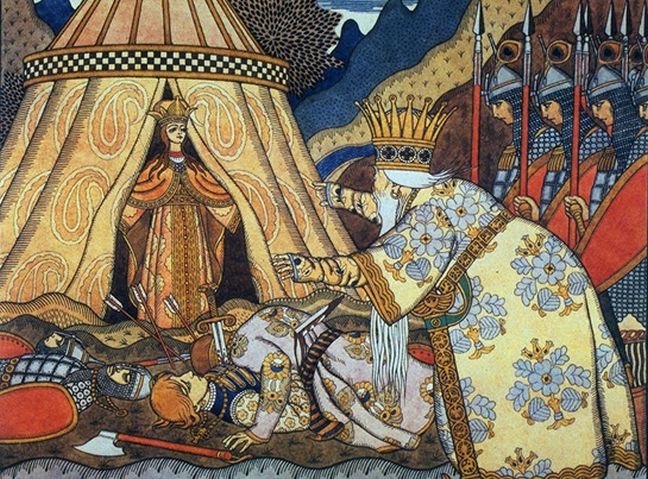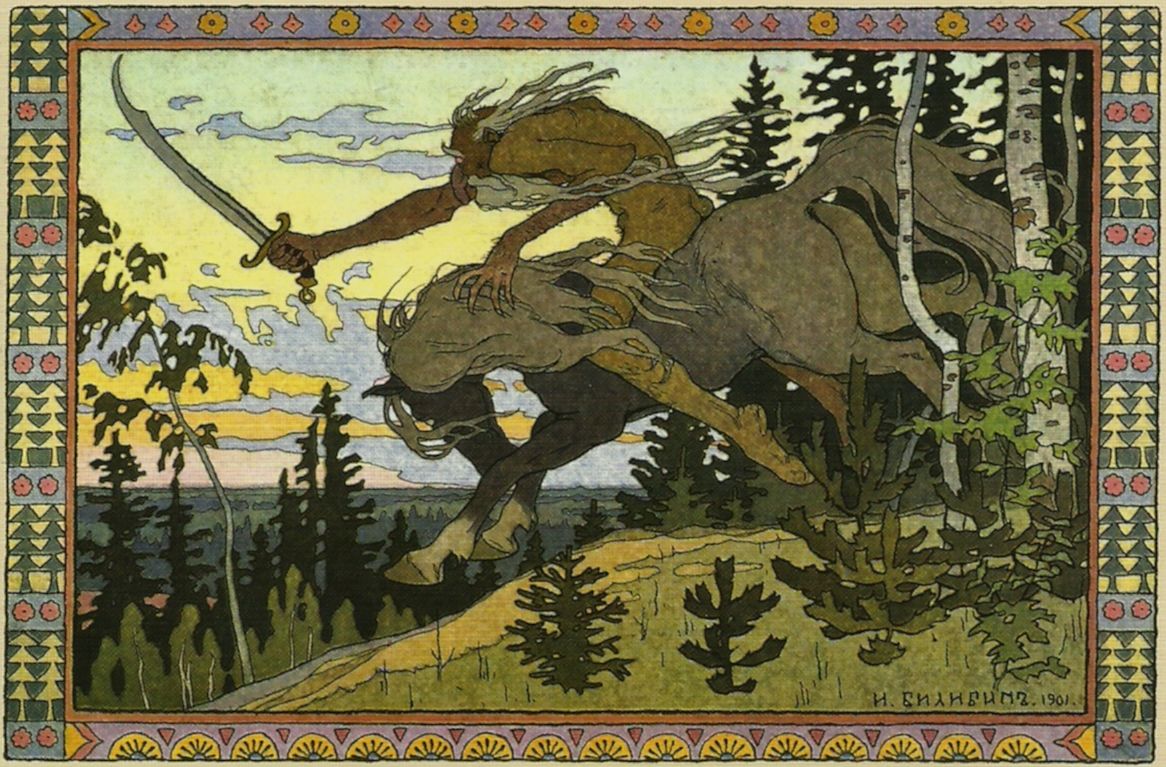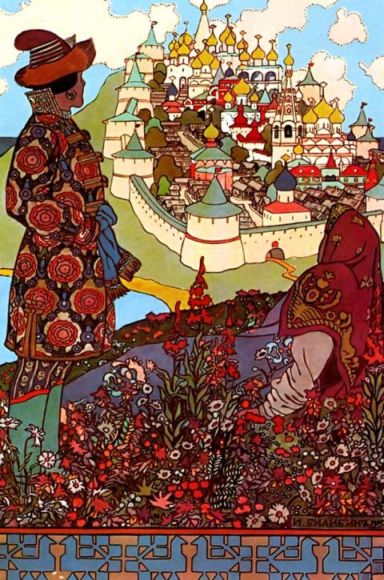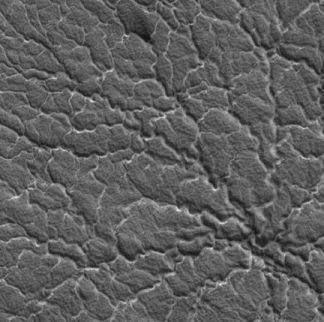What follows is a retelling of The Tale of the Golden Cockerel by Alexander Pushkin. The illustration is by Ivan Bilibin, originally published in 1906.

Buyan sits in the sea more than 2,000 miles away from Ismailli, now in ruins but once a powerful city ruled by Tsar Dadon the Glorius. A strange tale of brutal ambition and cruel revenge links the Vanishing Island to that ghost-haunted place.
In his youth Tsar Dadon waged war against his neighbors, taking their lands and wealth for his own and subjugating their people, reducing thousands to a level barely on par with serfdom. For decades, Tsar Dadon ruled Ismailli and the surrounding, conquered realms. In his twilight years, after the death of his queen, the tsar set aside his war-like ways, believing Ismailli secure and feeling confident that his son, Prince Dadon, would rule one day.
But, as Tsar Dadon relaxed his iron grip, unrest spread through the conquered realms. The people nurtured deep-seated resentments against Tsar Dadon, and soon rebel armies formed. Surrounded on every side by determined enemies, Tsar Dadon grew frightened, for he never knew from which direction the next threat would come. Rumors to the west resulted in Prince Dadon leading Ismailli’s armies toward the setting sun, but then rebels struck from the east. If the armies marched to the north, rebels attacked Ismailli from the south.
“How can I defend my beloved Ismailli,” cried Tsar Dadon, “if I cannot meet the enemy on the field of battle?”
A stranger stepped from the crowd in the tsar’s court. He wore the ornate robes of an astrologer and wizard.
“O, Tsar Dadon the Glorious! Please heed my words,” the strange said, bowing low. “I am Nikto, and I alone possess the means to protect your beloved Ismailli.”
Tsar Dadon commanded Nikto to explain himself, and the wizard pulled a sack from his sleeve, and the pulled a fantastic golden cockerel from the sack. Its feathers gleamed in the sunlight spilling through the high windows in the court.
“Place the Golden Cockerel atop the highest spire in the center of Ismailli,” said Nikto. “When any enemy army approaches to within eight days march of Ismailli, the Golden Cockerel shall face their direction and cry out an alarum. Thus, O Glorious Tsar, you will be able to meet the enemy on the field of battle.”
Tsar Dadon said, “If what you say is true, return to my court in one year’s time, and I shall grant you any wish to just short of half my kingdom.”
“I accept your terms, O Glorious One, but be warned: Forget your promise, and doom shall be your reward.”
With that, the wizard vanished, leaving behind the Golden Cockerel. Tsar Dadon ordered the fabulous bird be placed atop the highest tower in the center of Ismailli.
A few days later, the Golden Cockerel faced to the south and cried out loudly, “Enemies approach from the south! In eight days, they reach Ismailli’s walls!”
The watchmen brought word of the alarum to Tsar Dadon, and he sent Prince Dadon out at the head of an army. They met the enemy on the field of battle four days away from Ismailli, and Prince Dadon returned victorious to be covered in glory. During the next several months, the Golden Cockerel performed just as Nikto had promised. Each time, Ismailli’s army commanded by Prince Dadon met the enemy on the field of battle and emerged victorious. Nearly a year passed, and the Golden Cockerel sounded another alarum. Prince Dadon rode away at the head of the army toward Shamakhi, Ismailli’s fiercest and oldest enemy.
More than a week later, Prince Dadon had not returned. Tsar Dadon, frantic with worry, commanded his armor and sword be brought to him, and he himself sallied forth at the head of an army for the first time in years. Near the western border of Shamakhi, the tsar looked down into a valley and the great slaughter that had taken place there. In the middle of the field of battle stood a lonely pavilion flying Shamakhi’s ancient flag.
Tsar Dadon rode to the pavilion and stumbled from his horse when he saw Prince Dadon sprawled dead on the matted grass in front of the pavilion. As he gathered his dead son into his arms, a beautiful princess of Shamakhi exited the pavilion.
“Welcome, O Tsar Dadon the Glorious,” the princess said. “Please enter my pavilion so that I may ease your grief.”
The tsar entered the pavilion. The princess washed his hands, feet, and brow, and bade him sit at a kingly table. She fed him fine foods and filled his flagon with excellent wine. Tsar Dadon ate and drank his fill. The princess bade him sleep on a kingly bed, and throughout the night she tended his grief-haunted sleep.
The tsar woke in the morning and said to the princess, “You shall return to Ismailli as my bride. You shall be mother to my new heir.”
The princess lowered her head and smiled. Tsar Dadon and the princess rode back to Ismailli. The people there lamented the loss of Prince Dadon, but they rejoiced that their tsar had a new bride of such exceptional beauty and grace.
“O, Tsar Dadon the Glorious! Please heed my words,” said Nikto as he appeared in the tsar’s court. “One year has passed, and I’ve come to claim my reward.”
“Welcome, Nikto,” said the tsar. “The reward is yours. Claim anything just short of half my kingdom.”
The wizard leered. “I claim the princess of Shamakhi.”
“Never!” Tsar Dadon said. “She you may not have!”
From a high window, the Golden Cockerel flew like a bolt from a crossbow. It landed on the tsar’s shoulder and pecked him once on the forehead. Tsar Dadon the Glorious staggered from his throne, fell to the floor, and died. The princess of Shamakhi walked to Nikto, and, when she placed her hand in his, both she and the wizard vanished. Shortly thereafter, Ismailli’s enemies triumphed, laying Tsar Dadon’s beloved city to waste.
Today, the Golden Cockerel sits atop the highest spire in the center of Retra, one of the two cities on Buyan. Nikto and the princess of Shamakhi live there as well, and neither one seems to have aged.
Tags: Buyan, place of power





